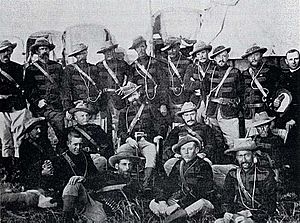Pioneer Column facts for kids
The Pioneer Column was a group of people put together by Cecil Rhodes and his British South Africa Company in 1890. Their goal was to take control of the land known as Mashonaland. This area later became part of Zimbabwe, which was once called Southern Rhodesia.
Contents
Why the Pioneer Column Was Formed
Cecil Rhodes wanted to secure the lands of Matabeleland and Mashonaland. He wanted to do this before other European countries like Germany or Portugal, or even the Boers, could claim them.
First, in 1888, Rhodes convinced the Matabele King Lobengula to sign a special agreement. This agreement, called the Rudd Concession, gave Rhodes's company rights to mine for minerals and manage parts of Mashonaland. Lobengula ruled Mashonaland, sometimes using his power to collect payments and control people.
After getting this agreement, Rhodes then received permission from the British government. This permission, called a charter, allowed his British South Africa Company to act in the area. The next step was to move into and settle the territory.
Getting the Column Ready
Military experts thought it would take many soldiers and a lot of money to take control of the land. They believed King Lobengula would fight back when he realized Rhodes wanted more than just mining rights.
However, a young adventurer named Frank Johnson, who was 23, offered to get the job done with only 250 men. He said he could do it in nine months for a much lower cost. Frederick Selous, a famous hunter who knew Mashonaland well, agreed to be their guide.
Johnson advertised for volunteers in Kimberley. He offered each person a large piece of land (about 1,200 hectares or 3,000 acres) and 15 mining claims. Rhodes advised Johnson to pick volunteers who came from wealthy families. The idea was that if these young men faced danger, their families would likely ask the British government for help.
In the end, Johnson's column had 180 regular settlers. It also included 62 wagons and 200 volunteers. These volunteers later became the start of the British South Africa Police. Another group of 110 men, 16 wagons, 250 cattle, and 130 extra horses joined the column later. The soldiers had Martini-Henry rifles, revolvers, small field guns, and Maxim machine guns. They even had an electric searchlight, which they used to scare away Matabele warriors who were watching them.
Moving In and Settling
The journey began on June 28, 1890, from Macloutsie in Bechuanaland. On July 11, they crossed the Tuli River into Matabeleland. They traveled north-east and then north for about 650 kilometers (400 miles). Their original plan was to stop at an open area called Mount Hampden, which Selous had explored earlier.
However, on September 12, the column stopped about 15 kilometers (9 miles) before Mount Hampden. They found a flat, marshy area next to a steep, rocky hill. This place is known today as the Harare Kopje. The day they arrived, September 12, was later celebrated as a public holiday in Rhodesia. The British flag, the Union Jack, was raised there the next day, September 13, at what they called Fort Salisbury.
During their journey, they founded three towns. The first was Fort Victoria (renamed Masvingo in 1982), established in early August. It was located at the start of an easy path leading up from the low-lying area called the Lowveld. The second town was Fort Charter, built on a plateau about halfway to their final destination.
The Pioneer Corps was officially ended on October 1, 1890. Each member was given land to start farming.
What Happened Next
The arrival of the Pioneer Column had a huge impact. Mashonaland and Matabeleland changed from quiet, undeveloped areas. They had been like this since the decline of the Mwenemutapa state, which started about 400 years earlier when the Portuguese arrived.
The local Shona and Matabele people began to join the modern Western world. This happened partly because of a new tax on homes. This tax encouraged African men to earn money by working for wages instead of relying only on their traditional farming and trade.
A new group of leaders took control from the old Iron Age kingdoms. These new leaders showed off their advanced technology and their strong belief in their own achievements. A new way of life and new beliefs were also introduced, which greatly changed the culture of the local people. This also helped to stop their population from declining.
Special Medal
In 1927, the government of Southern Rhodesia created a new British South Africa Company Medal. This medal was given to remember the Pioneer Column of 1890. It looked just like the medals given for the First Matabele War and Second Matabele War. However, this new medal did not have any battle details on its back.
See also
- Nehanda Nyakasikana
- Shangani Patrol


